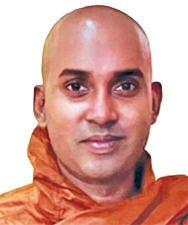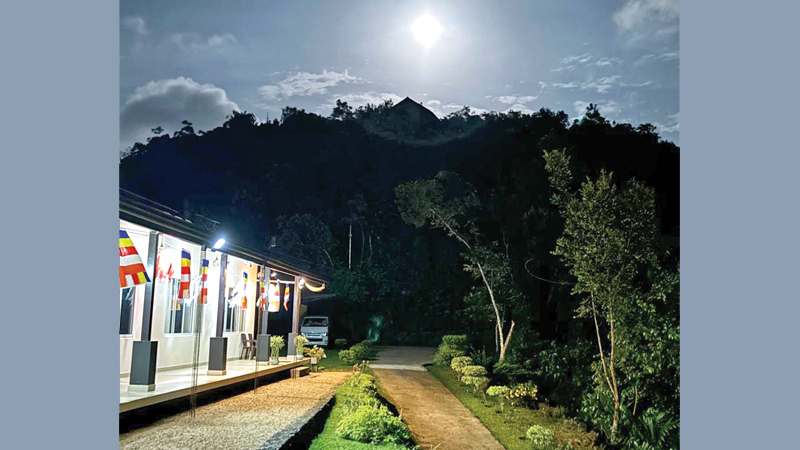Continued from last week
 Ven. Seeladassana Thera was once an investment banker based in New York, he found his true calling in the Buddha Dhamma as a young adult and has never looked back. He is now the chief preceptor of the Sihananda International Meditation Community founded in a rural locale in verdant Balangoda. Last week Ven. Thera talked about what inspired him to join the Bhikkhu order and the monastery he founded. This week Bhante discusses questions pertaining to the methods he uses to teach meditation and other noble aspects of the Buddha’s teaching.
Ven. Seeladassana Thera was once an investment banker based in New York, he found his true calling in the Buddha Dhamma as a young adult and has never looked back. He is now the chief preceptor of the Sihananda International Meditation Community founded in a rural locale in verdant Balangoda. Last week Ven. Thera talked about what inspired him to join the Bhikkhu order and the monastery he founded. This week Bhante discusses questions pertaining to the methods he uses to teach meditation and other noble aspects of the Buddha’s teaching.
Q: Your practice closely follows the Visuddhimagga. May I ask—with the Sutta Pitaka offering direct instructions from the Buddha himself on meditation and the path to Nibbāna—what draws you to rely on Buddhaghosa’s systematisation?
How do you reconcile any differences between the commentarial tradition and the early discourses?”

Ven. Seeladassana Thera
A: This might come as a complex answer to a simple question, but my intention is driven by the desire to give you a complete answer. Any phrase in any of the Pitakas will have someone interpreting that phrase. Who interprets it? The reader of the sentence! And it could be you or me or someone else. When we read the phrase we interpret it with our level of wisdom. Sometimes, we capture the meaning, and sometimes we may not. The wiser we are, the closer we are to the true meaning.
The earlier commentaries were led by Venerables who understood the meaning and also believed that future generations will not have the wisdom to be able to interpret correctly. So these Venerables gave more information to make up for any lack of wisdom.
When we begin to read the Suttas and Ven. Buddhaghosas’s compilation, it becomes clear that the meanings begin to coincide at the higher levels of our understanding (basically when our wisdom improves).
The seven stages of Purification can be connected to the Rathavinīta Sutta in the Majjhima Nikaya and the portions of the Paticca Samuppāda are derived from the Suttas.
How does a person meditate Paticca Samuppāda? Why are people not discussing the wisdom that arises from this? The Suttas show the methodology, but many people don’t have the wisdom to interpret it, so they choose to ignore it. Ven. Buddhaghosa’s work provides information to fill “our” blank spots so we can understand and thereby practise.
Q: Do you see the Visuddhimagga as a complete and reliable guide to the Buddha’s meditation path, or as an interpretive aid?
A: It is a complete guide because it details the steps on how to meditate. For example, how does a person discern kamma? The details are available. Remember that kamma is a word and different people can understand it in different ways. But the Visuddhimagga details the qualities of kamma and how to discern them. So, when a person is doing the fourth stage of Purification derived from the Rathavinīta Sutta, then he knows how to do it because all kammas have specific characteristics. The mind has to see these qualities. Seeing the word or reciting the word is not enough. The qualities that associate the aggregate have to be known.
Remember everyone will interpret the meaning of the Dhamma. Those who have wisdom and paramis will interpret correctly. Others will not. So, we have to make sure the meaning we get is always accurate and Ven. Buddhaghosa’s work helps that.
Q: If there appears to be a divergence between the Sutta method and the Visuddhimaggas method—for example, in the description of jhānas or insight stages—how should a practitioner navigate that?
A: The first step to navigate any “non-understandings” of the texts is to develop Abhidhamma knowledge. Why? Abhidhamma directly deals with the true characteristics of ultimate reality. What are the true qualities of the first jhāna? It has the five jhāna factors with a certain level of intensity. There also has to be an object for concentration. It cannot be an object that is always changing which means that it is a concept (except sixth and eighth jhāna). The meditator then absorbs himself into this object and is said to have reached first jhāna. Once we identify the object using the correct foundation knowledge then it is easier to match the Sutta together with the Visuddhimagga. The second step is, of course, practising the meditation.
The jhāna attainer will also understand that when strong concentration is reached, millions of jhāna minds will arise one after the other. This means that the person cannot focus on the rapture or bliss he has, even though they are arising. But there is powerful rapture and bliss, and this is taught both in the Sutta and the Visuddhimagga. When the concentration is weak, the jhāna will not last and fade away. All these experiences can be understood when we match the Abhidhamma with practice.
Q: What are the challenges in teaching deeper aspects of the Dhamma such as Nibbāna or sunnatā to laypeople?
A: The biggest challenge is removing Dhamma misunderstandings from a person’s mind. Then the next challenge is to convince people that the Dhamma is extremely deep and we cannot just think about the Dhamma and understand it in one day. Please remember the Buddha teaches us to continuously purify the mind. Which means our perception and wisdom are changing and the way we understand subjects such as Nibbāna or sunnatā changes. Remember all five aggregates have the void characteristic. Nibbāna also has the void characteristic.
When the true nature of the five aggregates becomes clearer then one’s understanding of Nibbāna becomes clearer. But not many people want to discern the five aggregates. They want to understand Nibbāna and voidness by thinking, but not by developing wisdom according to the Buddha’s teachings. This type of thinking leads to a lot of false attainments. The Saddhammapatirupaka Sutta details that false attainments can lead to the downfall of the Sāsana.
Q: How do you personally reflect on anicca, dukkha and anattā in day-to-day contemplation?
A: We have to be careful when we use words. The word “reflect” can also mean “think”. Thinking is not sufficient enough in advanced meditation. In advanced meditation, a person has to discern. How do they discern? When there is concentration, the mind can see the nature of rise and fall of the five aggregates. Upon discerning this rise and fall, then he contemplates anicca. Rise and fall and change are the characteristics of anicca.
This discernment then allows the yogi to know that the aggregates are constantly oppressed and thereby can contemplate dukkha. Since there is always rise and fall there is no control, so they are anatta. If the meditator just thinks that an object is anicca without seeing the true nature of rise and fall, then he cannot fully remove ignorance about the five aggregates. Anyone meditating anicca, dukkha and anatta has to come to these levels and meditate accordingly.
Q: How can anyone interested in the retreats contact the Ven. bhikkhu?
A: I am always willing to help serious practitioners. They have to follow the five precepts if a layperson and full Vinaya rules if a bhikkhu. After that, they need full dedication and effort. If you think you can do this, then send us an email and we can connect, talk and decide whether this is a suitable participant or not. If anyone requires more information about the centre and retreats, they may contact Ven. Thera at the e-mail address [email protected].






